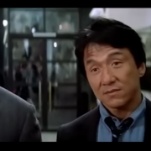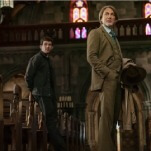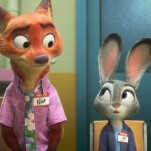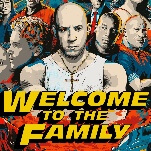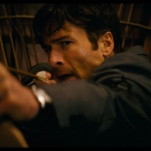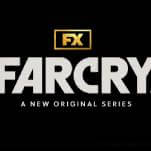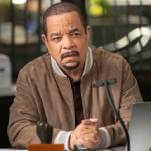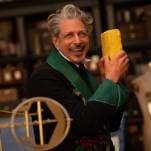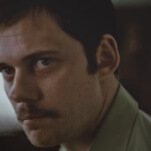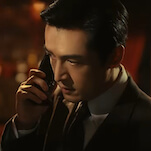There is no good reason why I haven’t seen Howard Hawks’ The Thing From Another World or John Carpenter’s The Thing until recently. Both men are national treasures. The films are considered classics. Yet I never quite got around to seeing them, perhaps because in the abstract, The Thing From Another World sounds ridiculous. Reduced to mere plot summary, it sounds more like the rightfully forgotten dreck the gang over at Mystery Science Theater 3000 would heckle rather than a timeless classic.
The cheese begins with a title that sounds both generic and like a parody of hyperventilating sci-fi titles. Then there’s the film’s monster (James Arness), a lumbering oaf who looks a little like Herman Munster’s socially maladjusted Martian cousin. He’s also, it should be noted, a super-intelligent vegetable from outer space, a sort of sentient, malevolent carrot with no mercy or emotion. When the film’s egghead scientist breaks the news that the creature menacing them is essentially an evolved houseplant, I couldn’t help but think of Troll 2, another film about blood-crazed plant life with a slightly less sterling reputation than The Thing From Another World.
The Thing From Another World also features one of the most ridiculous archetypes in sci-fi and horror: the mad scientist (Robert O. Cornthwaite) willing, even eager, to sell out his fellow human beings so he can join forces with a sinister alien life form eminently more interested in drinking his sweet, sweet blood than forming some sort of mutually beneficial partnership. Do these unions of the damned ever end well? No, they do not.
Here’s the thing about The Thing From Another World: It sounds terrible but is actually pretty great. Though Christian Nyby is credited as the director, the film is almost universally regarded as the work of Hawks, a prolific and versatile filmmaker who flitted from genre to genre while specializing in screwball comedy and film noir. The Thing From Another World has all the hallmarks of a Hawks film. Like so many of the auteur’s masterpieces, it concerns a community of professionals who view conversation as a linguistic battle in which only the fastest and funniest survive: Frequent Hawks screenwriter Charles Lederer wrote a spectacularly clever script filled with slangy one-liners and good-natured gibes the cast delivers at breakneck speed.
In this case, the community is a group of soldiers, scientists, and a solitary newspaperman chasing the story of the millennium: an unidentified flying object that has crash-landed near the North Pole with an apparently dead space alien inside it. At first, the men are overjoyed to have made such a miraculous discovery, but it isn’t long until sinister things start happening and it becomes apparent the dead alien isn’t dead at all.
But men being men, not even the looming specter of death from above can keep them from chasing the fairer sex. It turns out the threat of interplanetary apocalypse is a terrific catalyst for flirting, as evidenced by a scene in which stalwart hero Kenneth Tobey banters up a storm with secretary Margaret Sheridan. In Hawks’ testosterone-fueled world, the battle between the sexes almost invariably ends in a truce between the sheets, but the women are as strong, sassy, and smart as men, if not more so.
Now comes the part where I delineate how Hawks, screenwriter Lederer, a gifted cast, and, I suppose, Nyby to some extent (like many Hawks acolytes, I like to imagine his role on the set was limited to fetching Hawks’ coffee and shining his shoes) transform each of the film’s possible fatal shortcomings into strengths. Let’s start with Cornthwaite’s scientist, eager to join forces with the evil plant-man from outer space. In the hands of a less-capable actor, the character could easily have come across as a figure of crazed camp, a quintessential mad scientist frothing at the mouth with a crazed gleam in his eyes. Thankfully, Cornthwaite underplays the role beautifully. He’s mad as a hatter of course, but there’s a method to his madness. To Cornthwaite, the creature played by Arness represents a scientific ideal: a genetic miracle that’s all intelligence, zero emotion. It’s easy to see why Arness could fascinate a man so closed off from his own humanity.
Like Steven Spielberg in Jaws, Hawks smartly doles out stingy glimpses of his monster. We feel the effect he has on the psyches of the soldiers and scientists profoundly, even when he’s not present. And when Arness appears onscreen (we don’t get a sustained look at him until the film is nearly over), it’s absolutely terrifying. Hawks and his collaborators trust audiences enough to know that what dreamers in the dark imagine is happening is almost invariably more frightening than what they can show.
The Thing From Another World has a title and premise straight out of the big book of ’50s monster mega-cheese, but the filmmakers Trojan Horse a smart, scary, funny, and even philosophical fright film into the gaudy shell of drive-in movie schlock. The title may be hyperbolic and campy, but everything else about the film is refreshingly sophisticated. Writer-director-composer John Carpenter is a huge fan of The Thing From Another World; clips from it can even be seen in Halloween, and he provided an audio commentary for the film’s DVD. But his version of the story deviates wildly from Hawks’ and hews more closely to Who Goes There? the John W. Campbell, Jr. novella that inspired both films.
As the film’s terse antihero, Kurt Russell receives one of the all-time great introductions. Sporting a wild-man beard and nursing a bottle of liquor that serves as an ever-present prop, Russell whiles away the endless hours at a remote base playing chess with a gloriously primitive computer whose voice (provided by Adrienne Barbeau, Carpenter’s wife at the time) provides the only female presence in the film. The computer wins, but Russell gets the last laugh when he pours liquor on the uppity computer while hissing, “Cheating bitch.” In about a minute, Russell makes an indelible impression and we learn everything we need to know about him: He’s tough, funny, smart in a non-Poindextrous fashion, and, like pretty much every character Russell has ever played, a total fucking badass.
He’s in good company. The Thing boasts a killer cast of character actors: Wilford Brimley, David Clennon, Keith David (who nearly steals the film through the hypnotic power of his ominous and alluring voice), Richard Masur, T.K. Carter, beetle-browed über-WASP Donald Moffat (who once had a monopoly on the disapproving-aristocratic-patriarch roles Frank Langella now owns), and Richard Dysart.
The Thing occupies an even more ruggedly male universe than The Thing From Another World. The men of the film inhabit a brutal realm where survival trumps all other considerations. They’re shaggy and borderline feral and have been without the civilizing touch of a woman, or a shower, for far too long. They’re lonely and sleep-deprived and not exactly the picture of mental health to begin with, so it doesn’t take much to upset their delicate equilibrium.
The Thing marked Carpenter’s introduction to major-studio filmmaking, and he made the most of the resources afforded him, hiring Ennio Morricone to compose the score (a rare instance of Carpenter not handling score duty himself) and special-effects wizards Rob Bottin and Stan Winston to make the film’s stomach-churningly creative and well-designed monsters. Morricone’s synthesizer-heavy score sets an appropriately creepy mood—synths are the musical equivalent of ice—augmented by eerie sound design that transforms the howling winds of the arctic into a symphony of ominous atmosphere.
From the very beginning, something seems terribly awry. Carpenter lets the suspense build organically, alternating long stretches where very little happens with staccato bursts of Fangoria-ready ultra-violence. (Many of the negative reviews the film received at the time can be boiled down to, “Ewww! Gross!”) As in The Thing From Another World, the men of The Thing are not alone. They’re the unwitting hosts, in a literal sense, of an alien life form able to perfectly imitate the look, voice, and personality of their hosts.
As in the simpatico versions of Invasion Of The Body Snatchers, it’s hard to say what represents the greater threat: a malevolent outside force intent on doing us harm or our own paranoia, fear, and hysteria. It’s all very “Monsters Are Due On Maple Street” as the men struggle to hold it together and ascertain who among them has been infected and who hasn’t.
Russell is a quintessential alpha male. His authoritative presence implicitly assures us that everything will be okay, which is why he made for such a terrific villain in Death Proof. So when even badasses like Russell and David seem completely freaked out and lost, anything can happen. Carpenter undermines our sense of security in other ways as well. Unlike The Thing From Another World, there is no romantic subplot to lighten things up or inject a little estrogen into the mix. Although there are moments of extremely dark comedy early on, after a certain point, the humor stops and with it any form of release from the almost unbearable tension of the film’s third act. The Thing sustains its grim, uncompromising sensibility to the bitter end. Although the studio asked Carpenter to film a happy ending, he never reportedly never showed it to test audiences. Carpenter sadistically avoids giving audiences any relief throughout the film; why would he change course at the last moment?
Like the novel that inspired the various versions of Invasion Of The Body Snatchers, the premise of The Thing is extremely conducive to political and social allegory; as long as there are scaremongers, hysterics, bullying Wisconsin senators, and conservative all-news cable channels out there trying to convince us that the enemy is in our midst, passing unrecognized as one us, the film’s message will remain timely and potent. So it doesn’t surprise me at all that there’s a prequel in the works. Now is as good a time as any to revisit the originals and, as always, keep watching the skies.




















